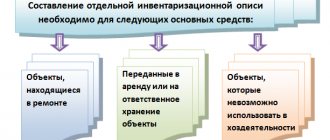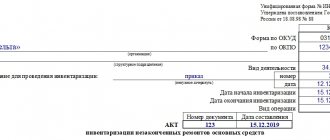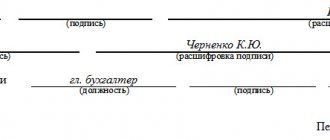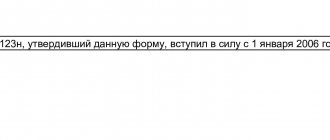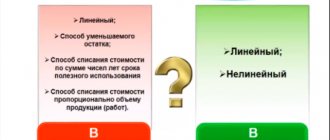A matching statement is a document on the basis of which the head of an organization can obtain information about how correctly and timely the accountant reflects in the accounting operations the accounting, movement and disposal of the organization’s property. Article 11 of the Federal Law of December 6, 2011 No. 402-FZ “On Accounting” requires all organizations to conduct an inventory of their assets and liabilities. The results are subject to documentation.
Unified forms of such primary accounting documents as matching statements of the results of inventory of fixed assets (form No. 18) and inventory items (inventory, form No. 19) have been approved.
Main purpose
Carrying out accounting is a mandatory procedure, during which discrepancies are almost always inevitably discovered:
- surplus;
- shortage.
All these discrepancies must be recorded in writing. The reporting procedure is necessary, first of all, for the company itself, because:
- Thanks to detailed accounting, you can correctly draw up accounting documents.
- It is possible to analyze the causes of shortages and reduce their volumes.
- You can see weaknesses in the storage system, transportation of goods within the enterprise, and in the work of employees, which leads to discrepancies in results.
NOTE. The statement is filled out in all cases during accounting - both scheduled and extraordinary (for example, after the dismissal of one financially responsible person and the transfer of his powers to a new employee).
conclusions
A matching statement is drawn up only if the inventory reveals a discrepancy in the actual availability and documentary evidence of existing fixed assets.
For leased properties, the matching paper is drawn up separately, indicating the lessor. The documents must be signed by both the responsible persons and the accountant.
If there are shortages, a commission is appointed and the person responsible is looked for. First of all, they ask financially responsible persons.
In any case, the document is written in two copies, each of which is given for its intended purpose to interested parties. Based on this paper, responsible persons will report to the manager and the employer.
Why do the results differ?
It is obvious that the results of counting commodity units, materials, raw materials, products and other material assets may differ from those presented in accounting documents due to inattention. Moreover, an error can occur at several stages at once or at one of them:
- Errors during counting are the most likely and real reason.
- Errors when drawing up a particular document with balances.
Along with this, the reasons for the discrepancies may be related to the following factors:
- re-grading;
- theft;
- loss of an item (due to inattention);
- cashier error (the item was not punched and was simply “handed over” at the checkout).
Analyzing specific causes is always a complex process. As a rule, the results of only one inventory, presented in the reconciliation sheet, are not enough. It will be necessary to conduct a series of inspections (including unscheduled ones) to establish the specific reasons for the discrepancies.
General information
There are several standard forms of such statements:
- INV-18 (the difference between OS and intangible assets is displayed);
- INV-19 (deviations from actual data on inventory and materials are recorded in it).
Already at the end of the year, inventory comparison sheets of the INV-26 form are used to display the results of inspections for the entire reporting period.
Even before filling out the statements, the responsible person must make sure that all data and calculations were correct. Only after a thorough check are comparison sheets drawn up and inventory results are summed up.
These forms of documents are needed to compare the actual indicators obtained with the data recorded in the accounting documentation. Filling out the inventory comparison sheet is carried out taking into account a number of specific features.
Even small discrepancies in inventory items or operating assets must be reflected in inventory reports. Additionally, accounting certificates are prepared, which indicate the reasons for the shortages. The directions of write-offs depend on this, they can be:
- theft;
- shortages;
- emergency situations (for example, natural disasters);
- damage to valuables due to the negligence of responsible persons.
Officials do not always know how to fill out the matching sheet correctly, in accordance with existing requirements. The following factors must be taken into account:
- differences in amounts caused by misgrading;
- re-grading of goods and materials.
Misgrading refers to the incorrect accounting of goods of any type due to incorrect assignment to one of the varieties. You can read more about what regrading of goods is in the article.
Drawing up inventory comparison sheets presupposes the need for further write-off of losses incurred within acceptable limits (limits of natural loss).
The surpluses or shortages generated during the inspection are indicated in the matching statements as they were assessed and reflected in the accounting records.
The procedure for compiling matching statements deserves special attention. An organization, or rather a responsible person, can use unified registers, where all indicators for inventory lists and reconciliation sheets are combined. They are also compiled if inventory items are not owned by the enterprise, but are listed in accounting. It can be:
- valuables transferred for storage;
- rented valuables;
- goods, materials transferred to the organization for their further processing and use.
During the inspection, a certificate of the results of the inventory check is drawn up. It is transferred to the owners of the valuables along with a copy of the inventory.
All matching statements can be filled out electronically or by hand. Let's consider the features of both matching statements in more detail.
Filling procedure
Results with discrepancies are not immediately entered into the form. Typically, the procedure looks like this:
- Workers participating in the inventory commission discover shortages and/or surpluses.
- They immediately record this information in their personal papers (draft).
- Then the data is re-checked to exclude the possibility of an error due to inattention (usually another employee recalculates it for greater reliability).
- If it is confirmed that the fact of a shortage or surplus actually exists, the inventory result is transferred to the final version - i.e. on the matching sheet.
Download the inventory matching sheet (form INV-19)
Download sample forms for inventory at the enterprise: INV-1 Inventory listINV-1a Inventory list of intangible assets INV-3 Entering data into the inventory list INV-4 Inventory of shipped ]INV-5 Inventory of goods and materials accepted for storage[/anchor] INV-6 Inventory of goods and materials on the wayINV-15 Inventory of cash availabilityINV-17 Inventory of settlements with buyers and suppliersINV-18 Comparison sheet of inventory results INV-22 Order for inventory INV-26 Accounting for inventory resultsHow is an inventory of materials carried out?
Form and sample document
If you use the most common form INV-19, you just need to fill out all the fields correctly. If you develop and use your own sample, then when drawing it up, it is important to take into account that the document contains the following information:
- Name of the organization, type of its activity, OKUD and OKPO codes.
- A link to the document that regulated the start of the inventory - usually a corresponding order is issued, which stipulates the timing of the procedure, the responsible persons and the chairman of the commission.
- The timing of the inventory is the start and end dates (sometimes they may coincide).
- Document number (consecutive numbering is used throughout the year or for other periods - at the discretion of the administration).
- Full name, full title of the position of the responsible person. This could be a warehouse manager, department manager, senior cashier/salesperson, administrator, etc.
- The main part of the comparison sheet is presented in the form of a table in which the inventory results are recorded. It is necessary to indicate only those groups of goods for which a shortage and/or surplus was detected (including as a result of misgrading). The INV-19 form contains 32 columns, including:
- name of the product (or other value), its grade, type;
- labeling of goods in the form of a code that is accepted in the nomenclature system in a warehouse or store;
- accounting results - with discrepancies in quantities and in rubles (both in surplus and shortage);
- discrepancies in regrading;
- finally calculated discrepancies (taking into account additional final checks).
- At the end of the statement, the financially responsible person once again puts his signature, which means that he has become familiar with the results.
NOTE. Amounts are indicated to the nearest kopeck. If the value does not contain kopecks, you can specify it in a simple format, for example, 1000 (rubles), rather than 1000.00 (rubles).
The INV-19 form is shown below.
Here's a finished example:
About the inventory procedure in the company
Briefly, the inventory procedure can be represented as follows:
- The manager issues an order in the INV-22 form, where he sets the deadline, a list of objects in respect of which the procedure will be carried out, and specifies other details and reasons for the inspection.
- The inventory commission begins work on the start date of the inspection. Calculations, weighings, and measurements are carried out, depending on what objects are being checked. The results are drawn up in the form of acts INV-1 (for fixed assets) and INV-1a (for intangible assets).
- Upon completion, the finished inventory records are handed over to the accounting department. There, if discrepancies are identified between the data in the documents and the actual ones, the accountant fills out a matching statement.
- Next, they find out why the surplus or shortage occurred, collect compensation from the culprit (if there is one), write off the losses or capitalize the surplus.
Simpler form
Each company has the right to decide for itself which form to use. At the same time, the INV-19 form is used very often - on the one hand, it is convenient, on the other, many companies continue to use it out of business habit. However, in some cases, a simpler version of the form may be useful, in which you can indicate a minimum of data:
- name of the company and warehouse, date of compilation;
- Name of product;
- its quantity (in fact);
- its quantity (according to documents);
- identified deviation;
- units;
- unit price;
- the sum of all goods by actual quantity;
- the sum of all goods according to the data in the accounting documents;
- signatures, positions of responsible persons, transcripts of signatures.
This option allows you to save significant time. It is used when carrying out accounting in small warehouses, when counting individual items (sections), as well as when re-counting if deviations are found that raise doubts (i.e. there is reason to think that the cause of the error is inattention).


